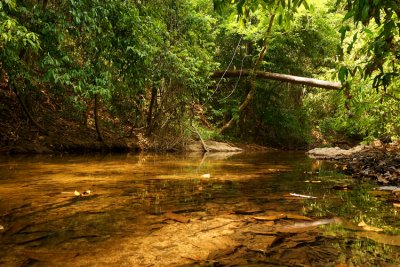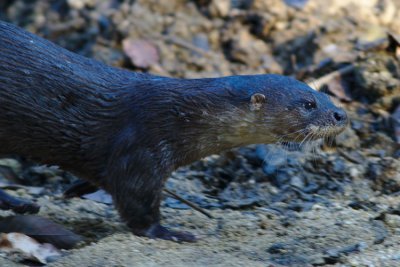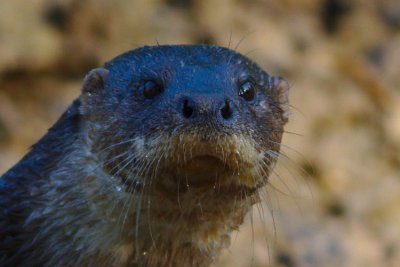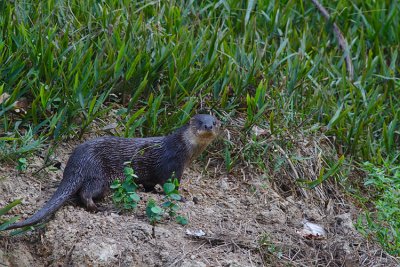IUCN/SSC Otter Specialist Group Bulletin

|
©IUCN/SCC Otter Specialist Group
Volume 33 Issue 2 (October 2016) Citation: Salahshour, F (2016). Confirmed Sighting of Lutra sumatrana in the Ulu Muda Forest Reserve in Kedah, Malaysia. IUCN Otter Spec. Group Bull. 33 (1): 68 - 72 Confirmed Sighting of Lutra sumatrana in the Ulu Muda Forest Reserve in Kedah, Malaysia Fariman Salahshour1 1 Email: panthera11@yahoo.com |

|
| (Received 12th August 2016, accepted 4th September 2016) |
| Abstract: A hairy-nosed otter was observed swimming in the Labua River at Kuala Labua (confluence of Labua and Muda rivers and location of Earth Lodge) in the Ulu Muda Forest Reserve, which is part of a 160k ha area of tropical rainforest in the state of Kedah in northern Malaysia. The sighting might be significant insofar that this is the first confirmed record of the species in the state of Kedah as well as for the habitat type. Other sightings and scientific literature generally associate the species with peat swamp forest. In this instance, the animal was observed in the small, clear, and fairly fast-flowing Labua river. No peat swamp habitat type is known in the immediate area. |
| Keywords:Lutra sumatrana, Ulu Muda, Kedah, Labua River, Earth Lodge |
| Française | Español |
INTRODUCTION
Earth Lodge is situated on the eastern bank of the Muda river where the clear waters of the smaller Labua merge with the murky waters of the Muda river. As the Labua converges with the Muda from the northeast, it forms a northwestern and a southeastern bank at this location. On April 8, 2016, the author observed an otter swimming in the Labua river downstream towards the confluence of the two rivers from his position on the Earth Lodge premises on the southeastern bank of the Labua. During this season, the water level had reached a very low point and was between ankle- and shin-deep at the section of river where the otter was observed. The animal was swimming along the northwestern bank of the Labua, intermittently raising its head above the surface but mostly remaining fully submerged, the shallow depth of the river notwithstanding. The distance between author and otter were an estimated 5 m to 6 m, which is the approximate width of the river.
As several sightings of smooth-coated otters had been made during the preceding days, the author did not assign any significance to the sighting then and surmised, based on the smaller size, to have seen a young smooth-coated otter striking out on its own, hence not in the company of a family group. This first sighting occurred in the morning hours and no photo could be taken. However, the author encountered another otter of the same size and appearance as the first animal some time later at the same location. Based on metadata of the photographs, the second sighting occurred at 8:44 AM. The otter was ambling on the northwestern bank of the Labua in a northeasterly direction (upstream). The author is convinced that this was the same animal he observed earlier, even though there are no photographic records of the first encounter for comparison and verification.
As the animal approached the location directly across on the opposite bank to where the author was positioned, it became aware of his presence and though it showed no sign of immediate alarm, after a short hesitation and furtive assessment of the author, it retreated up the bank and into the thick vegetation rather than continue on along the river bank.
Only during a recent review of the photographs of this otter, assumed to be Lutrogale perspicillata up to this point, did the author notice a slight oddity about the animal's nose and on closer examination it became clear that there was no distinct rhinarium, as should be the case with smooth-coated otters, and that the area between the nostrils was covered in hair. After comparisons with images from literature (Shepherd and Loretta, 2012) and internet resources, he concluded that this species could only be Lutra sumatrana. To put all doubts aside, friend and conservationist Jonathan Hunter forwarded the image to the OSG and Dr. Hiroshi Sasaki confirmed the identity to be L. sumatrana. Hopefully, this encounter will help shed some light on the ecology of L. sumatrana and draw attention to the significance of the Ulu Muda Forest Reserve as a viable habitat for the species.
REFERENCES
Shepherd, C.R., Loretta, A., (2012). Mammals of Southeast Asia, John Beaufoy Pub., Oxford, England
Résumé : Confirmation de l'Observation de Lutra sumatrana dans la Réserve Forestière l'Ulu Muda dans le Kedah en Malaisie
Une loutre de Sumatra a été observée nageant dans la rivière Labua à Kuala Labua (à la confluence des rivières Labua et Muda située à Earth Lodge). Le cours d'eau est localisé dans la réserve forestière d'Ulu Muda qui fait partie d'une zone de 160.000 ha de forêt tropicale humide de l'état de Kedah en Malaisie. Cette observation peut être considérée comme importante dans la mesure où c'est la première confirmation de la présence de l'espèce dans l'état du Kedah de même que pour ce type d'habitat. D'autres observations et publications scientifiques associent généralement cette espèce à la forêt marécageuse sur sols tourbeux. Dans le cas présent, l'animal a été observé dans le Labua, petite rivière limpide au courant assez rapide. Aucun habitat du type forêt marécageuse sur sols tourbeux n'est connu dans les environs.
Vuelva a la tapa
Resumen: Avistaje Confirmado de Lutra sumatrana en la Reserva Forestal Ulu Muda en Kedah, Malasia
Observé una nutria de Sumatra, nadando, en el Río Labua en Kuala Labua (confluencia de los ríos Labua y Muda, y lugar donde está el Earth Lodge), en la Reserva Forestal Ulu Muda, que forma parte de un área de 160.000 hectáreas de selva tropical en el estado de Kedah, norte de Malasia. El avistaje puede ser significativo, ya que podría ser el primero confirmado en el área en años recientes, y también lo es por el tipo de hábitat. Otros avistajes y la literatura científica en general asocian a esta especie con el bosque pantanoso de turbera. En este caso, el animal fue observado en el pequeño, transparente y bastante rápido río Labua. No se conoce que haya hábitat de pantano de turbera en el área cercana.
Voltar ao topo




